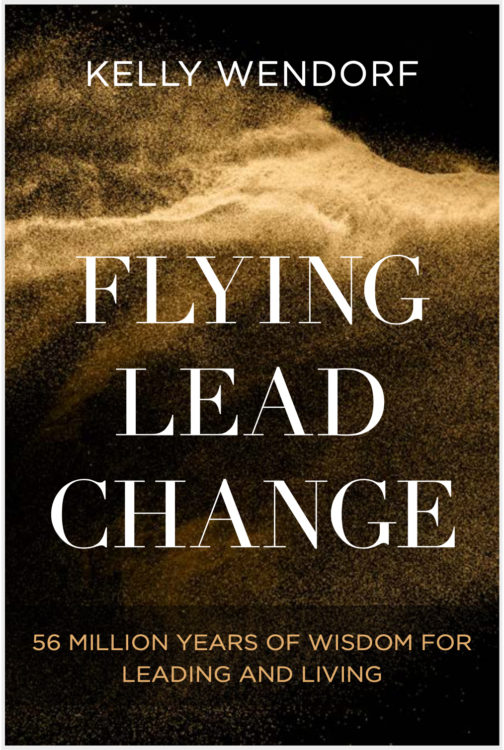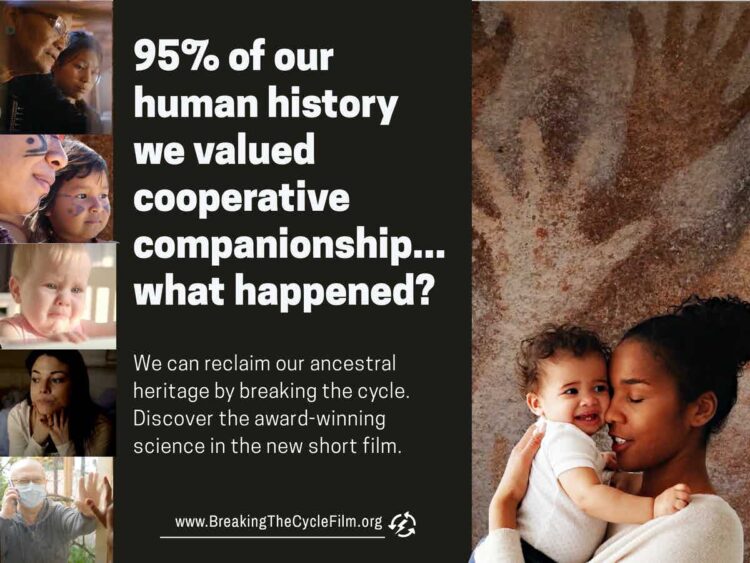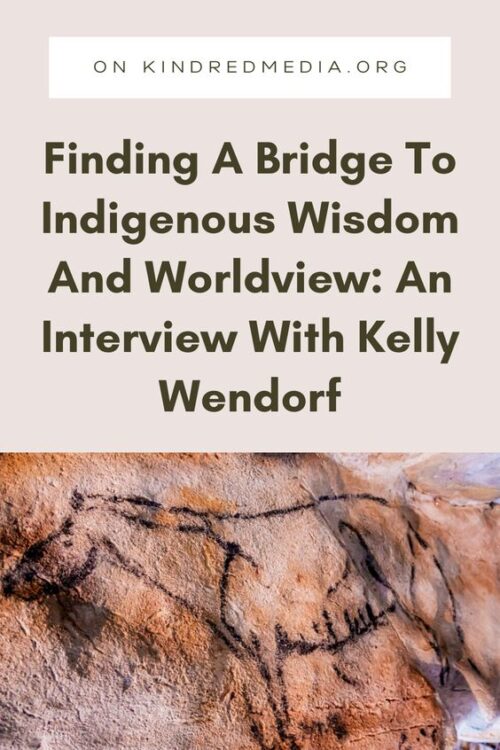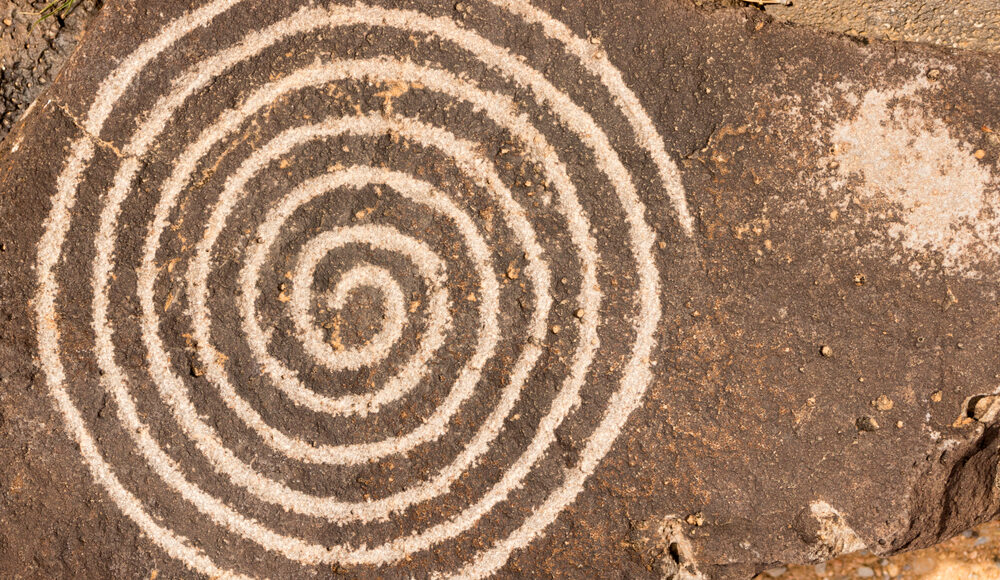The Spiral: An Ancient Model Useful for Contemporary Times
My left shoulder sports a tattoo––a rendering of a petroglyph in the shape of a spiral. In school, while listening to the droning on of teachers, I drew spirals all over my notebook. When playing at the beach with my two young children, it was playful co-mingling spirals we carved into the sand with long sticks.
 The spiral is the oldest, most ubiquitous symbol worldwide, adorning, caves, rock formations, and artifacts. The spiral appears in Neolithic societies in Europe and the Middle East, in China and Peru, Africa, throughout the Pacific in Polynesian and Maori societies, and all over North America.
The spiral is the oldest, most ubiquitous symbol worldwide, adorning, caves, rock formations, and artifacts. The spiral appears in Neolithic societies in Europe and the Middle East, in China and Peru, Africa, throughout the Pacific in Polynesian and Maori societies, and all over North America.
They are to be found everywhere in nature––in the structure of a snail’s shell, a nautilus, or a pinecone, the coil of a fern, or the whorl of our fingerprints. Buffalo travels in a spiral, and horses, too. The structure of DNA is a double-helix polymer, a spiral consisting of two DNA strands twisted around each other. Even the heart itself, scientists have recently discovered, is shaped as a spiral.
But what does the spiral mean, and why is it so omnipresent throughout human history? Nature, our wisest teacher, gives us some clues. And with it is an opportunity to apply the symbolism to our life and our work, informing a powerful new narrative and new framework towards resilience, wisdom, and evolution.
Consider the evolutionary intelligence behind nature. Life is never at a standstill; everything either evolves, adapts, or goes extinct. Life is perpetually cycling through phases specifically designed to push systems, organisms, and species towards a collective progression.
In nature, nothing argues with this momentum. The caterpillar doesn’t resist melting to become a butterfly, the tadpole doesn’t freak out when they grow legs, and the willow doesn’t try to live in the desert. But humans, especially modern humans, battle change and evolve all the time. Rather, we want the universe to bend to us and not the other way around. And this becomes our suffering.
A powerful framework

The spiral invites us to yield to the powerful forces of evolution, and instead walk the way of the reliable yet genius arcs of transformation available to us every day. It provides us with a framework to understand the evolutionary pathway of a life, an organization, a friendship, a career, or a country. According to the spiral, a lifetime does not travel in a straight line but cycles ever-proximate to the center––however one defines that center. The center could be your soul, your purpose, the core mission of an organization, a key value, or consciousness itself.
Imagine the spiral in three dimensions, instead of two. It spirals upwards and outwards into time and space. It cycles past various themes or dimensions, returning to those themes or dimensions again and again, but from a different (higher, more evolved, more mature, wiser) point of view. This is why it may seem like “we are back here again” dealing with that “same old issue of X”, and berating ourselves that “we’ve done that work already, yet here I am again”. We might notice we surface the same issues in a second or third marriage, or the same obstacles with a third product launch, for example. Yet the spiral reveals that we are not “back” here again; we are revisiting a theme but from a more mature and evolved perspective.
One of the consistent themes/challenges in my life is betrayal. It arises time and again, but every time I encounter it, I am equipped with more wisdom and a much more balanced perspective. It’s possible, as my life spirals upwards, this may be a pervasive theme…for whatever reason, perhaps ancestral trauma, DNA, karma, who knows? But I no longer fight its appearance, instead, I strive to deliberately use it as a foothold for more growth.
These themes often come along with what are called disruptors in biology. Disruptors are designed to interrupt old patterns and offer the opportunity for a species, organism, or system to “bounce” forward into a new evolutionary cycle. Disruptors often come in the form of a crisis, such as an illness or death, or sometimes they come in the form of something positive––a spiritual epiphany or a new career. They keep us growing (albeit sometimes begrudgingly), spiraling upwards, becoming the best version of ourselves we can be. Though uncomfortable, they push organizations and teams to make important changes so they survive. They interrupt a product launch, providing an opportunity to optimize. They stop communities in their tracks and evoke new solutions. Nothing is outside of the spiral. Even this essay itself is a form of disruption, interrupting a common linear narrative and breaking open new possibilities.
From this perspective, we see that there are tremendous forces at work that want us and our organizations to “bounce forward” and continue to evolve. All of life is supporting us to do so. This contradicts the concept of merely “bouncing back” after a crisis (back to baseline), but rather using nature’s adaptive cycle (a series of spirals) to propel us forward––to better, more optimal ways of being and doing. We can begin to see our life, our work, and our efforts within an evolutionary momentum and welcome the bends in the road, trusting their direction.
A powerful symbol
 n some ancient societies, the spiral was a snake, coiled in co-centric circles with a head and a tail. The snake represented transformation, life force, Mother Earth, rebirth, our connection to The Mother, and our fidelity to nature as a wisdom teacher. But patriarchal mono-theistic dominator societies tried to annihilate nature-centric cultures, driving them underground. To protect the symbol, these people removed the snake’s head and tail, leaving only a more innocuous spiral that would not attract the wrath of the dominators and colonizers.
n some ancient societies, the spiral was a snake, coiled in co-centric circles with a head and a tail. The snake represented transformation, life force, Mother Earth, rebirth, our connection to The Mother, and our fidelity to nature as a wisdom teacher. But patriarchal mono-theistic dominator societies tried to annihilate nature-centric cultures, driving them underground. To protect the symbol, these people removed the snake’s head and tail, leaving only a more innocuous spiral that would not attract the wrath of the dominators and colonizers.
Hence, the spiral is not only a framework for our way forward––personally and collectively, professionally and organizationally––it is a powerful symbol that reminds us of our roots, our connection to nature, and the transformative power available to us. The spiral as a symbol calls us back to a larger intelligence system, our mother. It is a symbol of our belonging to all of life.
The spiral supports us in the following ways:
+ It de-pathologizes and normalizes disruption––we recognize ‘setbacks’ and ‘breakdowns’ as evolutionary opportunities instead
+ It explains the repeated patterns and themes in our life, or the life of our business, product, or community
+ It helps us to harness natural forces that want us, and our organizations, to “bounce forward” and continue to evolve. If we don’t evolve, we become extinct
+ It reassures us that we are never lost (even though we may feel so), always orbiting around the core “premise/value / purpose/origin”
+ It teaches us that life is not linear
+ It reminds us that we are on the journey we need to be on
+ It assures us that we are part of a bigger plan
This is why the venerable spiral is the logo for EQUUS, and a tattoo on my shoulder. We partner with nature to liberate wisdom capacities and create conditions for transformational change. We trust the life-giving trajectory of the natural world and recognize that trajectory and those life forces are here to support us, not thwart us.
So what can we do to recognize and align with the powerful forces in our lives that the spiral represents?
+ Keep an image of a spiral somewhere close to remind you of its framework and
symbolism.
+ Recognize when resistance to change is present and nudge yourself forward gently.
+ Understand that the universe wants something for you
+ When you see an emerging pattern, reflect upon what’s been learned and appreciate how it’s different from the last time
Just like life is wanting a butterfly from a caterpillar, life is wanting something glorious for you too. Your job is to fling yourself wide open and say, “Yes!”.


